Valdichiana
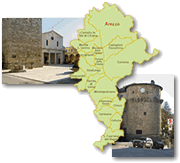
The navigability of the Chiana River and the expanses of cultivable land in the large valley whose products earned it the name "breadbasket of Etruria" in the Roman age, made this region an ideal spot for settling in antiquity. This fortunate circumstance is today testified throughout the territory by countless vestiges from antiquity to the Middle Ages.
For a historical overview of the emergences of archaeological and scientific interest in the Valdichiana, the must beginning of our itinerary is the Museo per la Preistoria del Monte Cetona, which illustrates the region’s settlement from the Middle Palaeolithic to the Bronze Age.
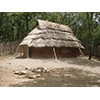
The Museum, opened in 1990, forms part of the Siena Museum System. It is located in the Town Hall of Cetona, a building dating from the second half of the 16th century. The objects, coming from the Cetona massif, document the various stages of population of the area, from the Middle Palaeolothic to the Bronze Age. Informative panels and dioramas illustrate prehistoric cultural evolution, with special attention to the village of Santa Maria in Belverde, highly significant for an understanding of the Bronze Age. Objects of ancient craftsmanship are displayed along with an environmental reconstruction enriched by findings from archaeologicial excavations in the surrounding areas.
In the vicinity of the museum is the Belverde Archaeological-Naturalist Park, established to safeguard and promote the sites in the area. Guided tours bring visitors into contact with the prehistoric villages in the Cetona area, surrounded by magnificent natural scenery.
(Mara Miniati)
After visiting the Museum and perhaps taking an organised excursion to the nearby Belvedere Natural Archaeological Park, take SS321/SP321 for a couple of kilometres, turn left onto SP20 and follow it for 5 kilometres more until you reach the historical centre of Chiusi. Here you can admire a complex hydraulic system made up of underground tunnels, dating back to the Etruscan epoch.
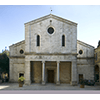
Known as Porsenna’s Labyrinth because tradition identifies it with the monumental sepulchre described by Roman scholar Pliny the Elder, it is formed by a close network of underground passages which formed the draining system conceived by the Etruscans in the archaic period (6th century B.C.) to exploit the infiltration and aquifer waters. The underground passages vary in size, are dug on various levels, and are connected to the dwellings by means of wells and cisterns. Recently cleared of the detritus that filled them, the tunnels can be visited today, entering from the Cathedral Museum and proceeding to a large cistern of the 1st century B.C. The cistern is formed by a room with a rectangular plan, surmounted by a double vault, where wells were sited for water supply.
(Graziano Magrini)
Also tied to the theme of water in antiquity is the archaeological museum of Chianciano Terme, 15 km from Chiusi, taking SS146/SP146 until SP30.
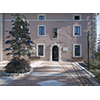
The Museum conserves archaeological material of the area, and belongs to the Museum System of Siena. Alongside the areas dedicated to dwellings, sanctuaries and the reconstruction of a chamber tomb of the 7th century B.C., is the fascinating section dedicated to divinities of health, tied to the theme of water. Particularly interesting are the terracotta pediment of a shrine found in the vicinity of F¨coli spring and the life-size chariot in bronze driven by the goddess Selene-Diana, found in the 19th century near the Sillene spring. Considerably interesting for the knowledge of the territory in the Hellenistic age, is the reconstruction of the quarters for making wine at the farm discovered near Poggio Bacherina. Finally, one section illustrates the exploitation of the spa waters of Chianciano during the Roman age. Currently under excavation, the large spa building in the locality of Mezzomiglio is reported to have been frequented by the poet Horace on the advice of Antonius Musa, physician to Augustus.
(Graziano Magrini)
Finally, for collections of an archaeological, artistic and scientific nature, a worthwhile visit is the renewed Museo dell’Accademia Etrusca in Cortona, located 60 km from the previous spot.
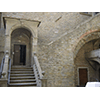
Originating as the "Society for the purchase of books" founded by the Venuti brothers in 1726, the Academy was constituted as the "Accademia di Scienze et Erudizioni" on November 9, 1727, the day on which the library and the museum of Abbot Onofrio Baldelli, a collector of naturalist specimens and Etruscan antiquities, was donated to it. In 1728, having become the "Accademia Etrusca delle AntichitÓ ed Iscrizioni", it represented a prime example of the cultural renewal of Tuscan culture that marked the first decades of the 18th century. In 1744, with the introduction of the so-called "Coritane Nights" – meetings held periodically among the members of the academy – the need was felt to study not only "physics" but also local history, antiquities and the arts. Accordingly, fossils and paleontological specimens, mineral and shells, destined to the Museum's Natural History Section, were presented and discussed.
The collections of the Museum, housed in Palazzo Casali, reflect the aims of the Academy. Visitors may follow three established itineraries (classical archaeology, Egyptian archaeology, and art history). From the collections, it is clear that the study, promotion and dissemination of natural history were important objectives of the Academy. The original core of the scientific material is the Baldelli collection, which includes naturalist specimens and some mathematical instruments. Particularly interesting are the pair of globes (terrestrial and celestial) dated 1714-15, purchased by Baldelli, and another celestial globe dated 1710.
The Library, annexed to the Museum, possesses a conspicuous heritage of books: very ancient and rare manuscripts, codexes and parchments dating from the 11th through the 19th century, rare printed texts from the 15th and 16th centuries and thousands of volumes from later times.
(Anna Toscano)
****************************
Texts by Elena Fani
English translation by Victor Beard
Last update 18/feb/2008



 = libraries and archives
= libraries and archives  = scientific research centers
= scientific research centers  = memorial places of scientists
= memorial places of scientists = public health places
= public health places = places of science and worship
= places of science and worship = places of technology
= places of technology  = museums and collections
= museums and collections  = villas and gardens of science
= villas and gardens of science

